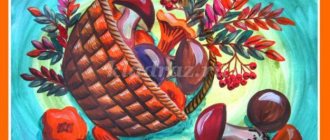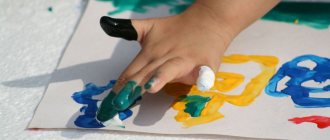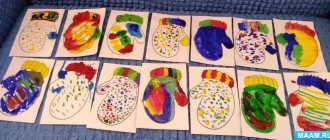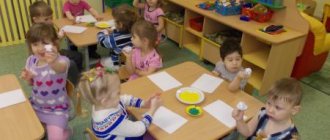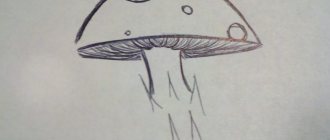Finger painting templates for kids
I highly recommend Elena Yanushko’s reusable educational drawing cards for children aged 1 to 2 years. But if you don’t buy them, you can get by with free templates.
For example, download and print suitable pictures from our article Pictures for drawing with plasticine - they are also suitable for paints. The advantage of drawing templates is that you will receive a masterpiece from a small artist with a clear plot with minimal effort on your part.
For example, templates for drawing rainbows, bee stripes and flower petals.
And below are templates for drawing watermelon seeds, apples on a tree, grapes on a vine. You can perform such work with your fingers, brushes, rollers, and other tools for making prints on paper.
Print finger painting templates
Simple templates with “spaces” for finger painting or DOT stamps are very popular in the West. There are even special markers for this type of creativity. It is difficult to find such markers in Russia.
Here you can read about similar drawing with smaller dots - drawing with cotton swabs - and templates for such drawing.
Therefore, as an alternative to drawing using such patterns with your fingers, use your imagination. “Circles” can be stamped with bottle caps, a cut-out stamp made of potatoes, sponges, eva, etc.
Below you will find black and white and color templates. Colored templates are, of course, more interesting and educational for children. But if it’s not possible to print them, download regular monochrome ones.
Color templates
Black and white templates
These are the same drawing templates that are presented for download above, but not colored.
Drawing tools other than paints
So, here is a list of tools for drawing with your baby:
- Finger paint,
- gouache,
- watercolor,
- wax crayons,
- pencils (pencils with a triangular cross-section are considered ideal for establishing a correct grip),
- felt-tip pens (water-based only),
- special thick DOT markers that leave large dots on a sheet of paper (they are also suitable for drawing on finger drawing templates),
- thick colored crayons for drawing on asphalt,
- plasticine (for plasticineography, preferably after 1 year),
- brushes (the smallest ones can be given a wide silicone brush from your kitchen),
- sippy cup,
- paper,
- An easel is an optional but nice addition for babies over one year old.

Introducing your child to finger paints
Dip your baby's finger into the paint. Swipe across the sheet. It may be necessary to repeat several times for the child to grasp the cause-and-effect relationship.
Then you can show how to mix paints of different colors - right on the sheet. Some experts recommend starting to get acquainted with colors with warm, moderately bright shades.
Do not forget to voice all your actions and the actions of your child, and name the colors of the paints.
Personal life hack: My kids learned to draw by smearing white porridge on the orange surface of their high chair tabletop. The action took place after eating. I took away the spoon, and replaced the porridge and the plate with others, so that the child would not get confused: when to eat and when to draw.
But there were zero worries about the child tasting the paint. However, there were few such attempts. Later, jars of finger paints began to be added to the porridge. When mixing white porridge and colored paints, the effect was very beautiful! And the sensory system is 100% involved.


